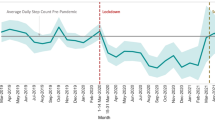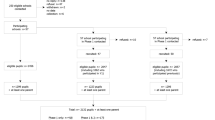Abstract
Accelerometry has become a mainstay approach for objectively monitoring children’s physical activity and sedentary time in epidemiological studies. The magnitude of effort underlying successful data collection, management and treatment is prodigious and its complexity has been associated with increasingly diverse methodological choices that, while defensible relative to specific research questions, conspire to undermine the ability to compare results between studies. Although respecting widespread calls for best practices, it is also important to openly share tools and resources supporting potential improvements to research practice and study design, thus allowing others to replicate, further improve, and/or otherwise build on this foundation. The International Study of Childhood Obesity, Lifestyle and the Environment (ISCOLE) is a large multinational study that included accelerometer-based measures of physical activity, sedentary time and sleep. This review summarizes the unique contributions of ISCOLE to the advancement of accelerometry in large studies of children’s behavior, and in particular: (1) open-access publication of the ISCOLE accelerometry Manual of Operations; (2) 24-h waist-worn accelerometry protocol; (3) identification and extraction of nocturnal total sleep episode time (with open access to editable SAS syntax); (4) development of the first interpretive infrastructure for identifying and defining an evolved list of sleep-related variables from 24-h waist-worn accelerometry; (5) provision of a detailed model for reporting accelerometer paradata (administrative data related to accelerometry); and (6) cataloging the most detailed and defensible list of accelerometry-derived physical activity and sedentary time variables to date. The novel tools and resources associated with these innovations are shared openly in an effort to support methodological harmonization and overall advancement of accelerometry in large epidemiological studies.
This is a preview of subscription content, access via your institution
Access options
Subscribe to this journal
We are sorry, but there is no personal subscription option available for your country.
Buy this article
- Purchase on Springer Link
- Instant access to full article PDF
Prices may be subject to local taxes which are calculated during checkout
Similar content being viewed by others
References
Caspersen CJ . Physical activity epidemiology: concepts, methods, and applications to exercise science. Exerc Sport Sci Rev 1989; 17: 423–473.
Sirard JR, Pate RR . Physical activity assessment in children and adolescents. Sports Med 2001; 31: 439–454.
Sallis JF, Saelens BE . Assessment of physical activity by self-report: status, limitations, and future directions. Res Q Exerc Sport 2000; 71 (2 Suppl): S1–S14.
Trost SG, McIver KL, Pate RR . Conducting accelerometer-based activity assessments in field-based research. Med Sci Sports Exerc 2005; 37 (11 Suppl): S531–S543.
Cain KL, Sallis JF, Conway TL, Van Dyck D, Calhoon L . Using accelerometers in youth physical activity studies: a review of methods. J Phys Act Health 2013; 10: 437–450.
Katzmarzyk PT, Barreira TV, Broyles ST, Champagne CM, Chaput J-P, Fogelholm M et al. The International Study of Childhood Obesity Lifestyle and the Environment (ISCOLE): design and methods. BMC Public Health 2013; 13: 900.
Riddoch CJ, Bo Andersen L, Wedderkopp N, Harro M, Klasson-Heggebo L, Sardinha LB et al. Physical activity levels and patterns of 9- and 15-yr-old European children. Med Sci Sports Exerc 2004; 36: 86–92.
Tudor-Locke C, Camhi SM, Troiano RP . A catalog of rules, variables, and definitions applied to accelerometer data in the National Health and Nutrition Examination Survey, 2003-2006. Prev Chronic Dis 2012; 9: E113.
Moreno LA, De Henauw S, Gonzalez-Gross M, Kersting M, Molnar D, Gottrand F et al. Design and implementation of the Healthy Lifestyle in Europe by Nutrition in Adolescence Cross-Sectional Study. Int J Obes (Lond) 2008; 32 (Suppl 5): S4–S11.
Yildirim M, Verloigne M, de Bourdeaudhuij I, Androutsos O, Manios Y, Felso R et al. Study protocol of physical activity and sedentary behaviour measurement among schoolchildren by accelerometry—cross-sectional survey as part of the ENERGY-project. BMC Public Health 2011; 11: 182.
Tudor-Locke C, Barreira TV, Schuna JM Jr., Mire EF, Chaput JP, Fogelholm M et al. Improving wear time compliance with a 24-hour waist-worn accelerometer protocol in the International Study of Childhood Obesity, Lifestyle and the Environment (ISCOLE). Int J Behav Nutr Phys Act 2015; 12: 172.
Masse LC, Fuemmeler BF, Anderson CB, Matthews CE, Trost SG, Catellier DJ et al. Accelerometer data reduction: a comparison of four reduction algorithms on select outcome variables. Med Sci Sports Exerc 2005; 37 (11 Suppl): S544–S554.
Tudor-Locke C, Barreira TV, Schuna JM Jr., Mire EF, Katzmarzyk PT . Fully automated waist-worn accelerometer algorithm for detecting children's sleep period time separate from 24-hour physical activity or sedentary behaviors. Appl Physiol Nutr Metab 2014; 39: 53–57.
Barreira TV, Schuna JM Jr., Mire EF, Katzmarzyk PT, Chaput JP, Leduc G et al. Identifying children's nocturnal sleep using 24-h waist accelerometry. Med Sci Sports Exerc 2015; 47: 937–943.
Sadeh A, Sharkey KM, Carskadon MA . Activity-based sleep-wake identification: an empirical test of methodological issues. Sleep 1994; 17: 201–207.
Meltzer LJ, Montgomery-Downs HE, Insana SP, Walsh CM . Use of actigraphy for assessment in pediatric sleep research. Sleep Med Rev 2012; 16: 463–475.
Meltzer LJ, Westin AM . A comparison of actigraphy scoring rules used in pediatric research. Sleep Med 2011; 12: 793–796.
Chaput J-P, Katzmarzyk PT, LeBlanc AG, Tremblay MS, Barreira TV, Broyles ST et al. Associations between sleep patterns and lifestyle behaviors in children: an international comparison. Int J Obes Suppl 2015 (this issue).
Tudor-Locke C, Mire EF, Barreira TV, Schuna JM Jr, Chaput J-P, Fogelholm M et al. Nocturnal sleep-related variables from 24-hour free-living waist-worn accelerometry. Int J Obes Suppl 2015 (this issue).
Matthews CE, Hagstromer M, Pober DM, Bowles HR . Best practices for using physical activity monitors in population-based research. Med Sci Sports Exerc 2012; 44 (1 Suppl 1): S68–S76.
Tudor-Locke C, Mire EF, Dentro KN, Barreira TV, Schuna JM Jr, Zhao P et al. A model for presenting accelerometer paradata in large studies: ISCOLE. Int J Behav Nutr Phys Act 2015; 12: 52.
Freedson P, Bowles HR, Troiano R, Haskell W . Assessment of physical activity using wearable monitors: recommendations for monitor calibration and use in the field. Med Sci Sports Exerc 2012; 44 (1 Suppl 1): S1–S4.
Martinez-Gomez D, Ruiz JR, Ortega FB, Casajus JA, Veiga OL, Widhalm K et al. Recommended levels and intensities of physical activity to avoid low-cardiorespiratory fitness in European adolescents: The HELENA study. Am J Hum Biol 2010; 22: 750–756.
Konstabel K, Veidebaum T, Verbestel V, Moreno LA, Bammann K, Tornaritis M et al. Objectively measured physical activity in European children: the IDEFICS study. Int J Obes (Lond) 2014; 38 (Suppl 2): S135–S143.
Barreira TV, Schuna JM Jr., Mire EF, Katzmarzyk PT, Chaput JP, Leduc G et al. Identifying children's nocturnal sleep using 24-hour waist accelerometry. Med Sci Sports Exerc 2015; 47: 937–943.
Tudor-Locke C, Ainsworth BE, Thompson RW, Matthews CE . Comparison of pedometer and accelerometer measures of free-living physical activity. Med Sci Sports Exerc 2002; 34: 2045–2051.
Treuth MS, Schmitz K, Catellier DJ, McMurray RG, Murray DM, Almeida MJ et al. Defining accelerometer thresholds for activity intensities in adolescent girls. Med Sci Sports Exerc 2004; 36: 1259–1266.
Evenson KR, Catellier DJ, Gill K, Ondrak KS, McMurray RG . Calibration of two objective measures of physical activity for children. J Sports Sci 2008; 26: 1557–1565.
Tudor-Locke C, Brashear MM, Johnson WD, Katzmarzyk PT . Accelerometer profiles of physical activity and inactivity in normal weight, overweight, and obese U.S. men and women. Int J Behav Nutr Phys Act 2010; 7: 60.
Tudor-Locke C, Camhi SM, Leonardi C, Johnson WD, Katzmarzyk PT, Earnest CP et al. Patterns of adults stepping cadence in the 2005-2006 NHANES. Prev Med 2011; 53: 178–181.
Tudor-Locke C, Brashear MM, Katzmarzyk PT, Johnson WD . Peak stepping cadence in free-living adults: 2005-2006 NHANES. J Phys Act Health 2012; 9: 1125–1129.
Barreira TV, Katzmarzyk PT, Johnson WD, Tudor-Locke C . Cadence patterns and peak cadence in U.S. children and adolescents: NHANES 2005-2006. Med Sci Sports Exerc 2012; 44: 1721–1727.
Healy GN, Dunstan DW, Salmon J, Cerin E, Shaw JE, Zimmet PZ et al. Breaks in sedentary time: beneficial associations with metabolic risk. Diabetes Care 2008; 31: 661–666.
Acknowledgements
We thank the ISCOLE External Advisory Board and the ISCOLE participants and their families who made this study possible. A membership list of the ISCOLE Research Group and External Advisory Board is included in Katzmarzyk et al. (this issue). ISCOLE was funded by The Coca-Cola Company.
Author information
Authors and Affiliations
Consortia
Corresponding author
Ethics declarations
Competing interests
The authors declare no conflict of interest.
Rights and permissions
About this article
Cite this article
Tudor-Locke, C., Barreira, T., Schuna, J. et al. Unique contributions of ISCOLE to the advancement of accelerometry in large studies. Int J Obes Supp 5 (Suppl 2), S53–S58 (2015). https://doi.org/10.1038/ijosup.2015.20
Published:
Issue Date:
DOI: https://doi.org/10.1038/ijosup.2015.20



